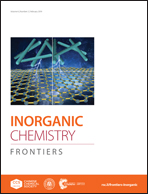Experimental characterization and first principles calculations of linear and nonlinear optical properties of two orthophosphates A3Al2(PO4)3 (A = Rb, K)†
Abstract
Two alkali metal orthophosphates, A3Al2(PO4)3 (A = Rb, K), have been synthesized through a high temperature solution method. Rb3Al2(PO4)3 and K3Al2(PO4)3 crystallize in different space groups Cmc21 and Pna21, respectively, and they both feature an [Al2P3O12]3− anionic framework composed of isolated PO4 and AlO4 tetrahedra. Their ultraviolet (UV) cut-off edges are both below 240 nm. The electron densities of states (DOS) calculations suggest that the interaction between oxygen and rubidium/potassium determines their band gaps and the nonbonding O 2p orbitals limit their UV cut-off edges towards the deep UV region. Rb3Al2(PO4)3 and K3Al2(PO4)3 exhibit second harmonic generation (SHG) responses of 0.6× and 0.4× KH2PO4 (KDP), respectively. The origin of the SHG effect was studied by SHG density calculations. From the dipole moment calculations and structure comparison, it is indicated that the arrangements of P–O and Rb–O/K–O groups play significant roles in the SHG responses of A3Al2(PO4)3 (A = Rb, K). Our results indicate that suitable arrangements of the units in phosphates may be essential to achieve large SHG responses.



 Please wait while we load your content...
Please wait while we load your content...